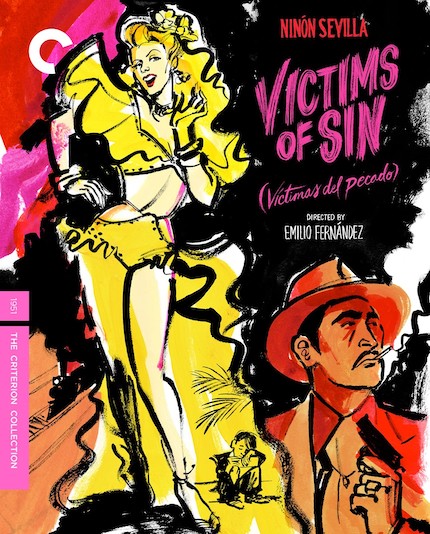VICTIMS OF SIN Blu-ray Review: Dance Hall Girl with a Baby in Highly-Charged Melodrama
Ninon Sevilla stars in the dazzling picture, directed by Emilio Fernandez and shot by Gabriel Figueroa, now on the Criterion Collection.

Me gusta mucho.
Victims of Sin (1951)
The film is now available in separate Blu-ray and DVD editions, via the Criterion Collection.
Melodrama gets a bad rap in some circles, and I totally get that. I'm not into weepy Hollywood movies that pile contrived tragedy upon unbelievable tragedy, amplified by forlorn heartbreak. Give me a Hong Kong melodrama from the '90s, though, and I am entirely down with that. Now I find myself enraptured with a Mexican melodrama from the early '50s.
Directed by Emilio Fernandez, Victims of Sin follows Violeta, who dances up a storm in a crowded cabaret, winning thunderous applause from everyone. Until, that is, another dancer brings home a baby sired by the domineering Rodolfo, who insists that she throw the infant in the trash. (Yes, into a literal trash can -- this ain't no music video, it's Mexican melodrama!)
Violeta rescues the infant and begins making all kinds of sacrifices on his behalf, which rockets the film into wildly unpredictable territory where mad jitterbugging alternates with highly-charged confrontations, large-scale fisticuffs break out in a bar fight sequence that rivals any ever seen in a Hollywood Western, a mariachi band trails a cabaret owner down a long street crammed with prostitutes -- and then resumes playing after the owner makes a paid conjugal visit and follows him back to work -- and more and more and more, all incredibly packed into a brisk 84-minute running time.
It's wild, baby, it's wild!
Even though I'm half-Mexican, the closest I came to classic Mexican cinema in my youth was a single visit to a packed Downtown Los Angeles theater to watch a Cantinflas comedy double-feature (without English subtitles) with my grandmother. The crowd roared, and my monolingual brother and I could only stare and wonder why everyone was laughing.
Out of context, Victims of Sin is fabulously entertaining, in part because it feels so different from the hundreds of films I've seen from the early '50s. The melodramatic aspects of the plot are not entirely dissimilar to what Hollywood was producing, yet I cannot think of any Hollywood movie that combined the elements of a traditional melodrama with a dance hall musical in a noirish crime-picture setting, infused with brazen energy and a maniacal edge to the heavy dose of machismo that is splashed across the screen.
It also looks distinctly different, because director Emilio Fernandez and cinematographer Gabriel Figueroa mix scenes that play out without dialogue -- yet are crystal clear in their narrative language -- with dazzling dance interludes, punctuating them with melodramatic, intimate closeups that amplify solitary faces so they appear to be under spotlights, in a manner that both flattens and heightens their emotions. (An interview with Rodrigo Prieto in the special features clarifies how it was likely done.)
Truly, Visions of Sin caught me off-guard and left me pleasantly surprised.
Special Features:
The Blu-ray sports a "new 4K digital restoration, with uncompressed monaural soundtrack," per Criterion. On my home setup (4K player and television), it upscaled beautifully, which made it easier to appreciate the splendid cinematography by Gabriel Figueroa, which I will definitely watch again, especially after watching the new, 16-minute interview with Academy Award-nominated Rodrigo Prieto.
As it happens, Prieto's family intersects with Figueroa's family, which is just a bit of the interview, which digs deeply into Prieto learning about cinematography and then being drawn to Figueroa's work. As an ace cinematographer, he explains in wonderful detail why particular shots look so good, and talks about the importance of lighting, as well as a very interesting technique with the use of red and green filters for a film that is presented in black and white.
Leading off the special features is another interview, about 17 minutes, with Viviana Garcia Besne, whose family goes back generations in Mexico, beginning as exhibitors before becoming producers. She is able to draw upon her experience and, like Prieto, all that personal history, to put a face on the production, and especially on the star, Ninon Sevilla, who was much more than an actress, dancer, and singer --- she was the true driving force behind the movie, and an uncredited producer and writer.
The third special feature is an archival episode of a television show that supplies rich context on cine de rumberas, including interviews with Ninon Sevilla, which helped to educated this escritor tonto.
There's a new English subtitle translation, and the subtitles are in white against the black backgrounds, so they are very easy to read and well-timed. The disk also includes a trailer for the 4K restoration.
The booklet contains a marvelously informative essay by scholar Jacqueline Avila that, happily, goes much deeper, with more context.
Summary: Buy it now from The Criterion Collection.







